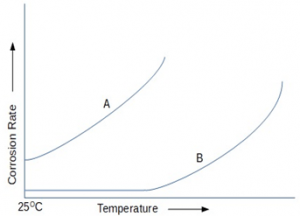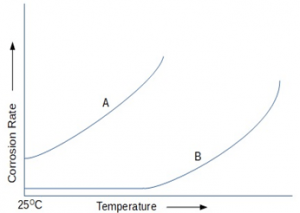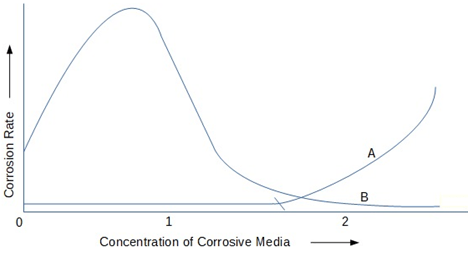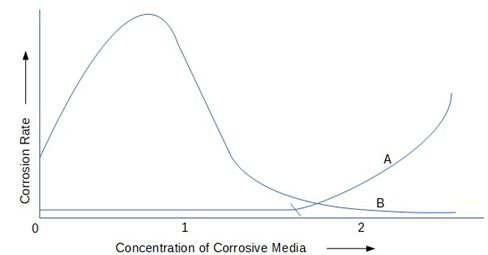This set of Corrosion Engineering Interview Questions and Answers for freshers focuses on “Effect of Temperature and Corrosive Concentration”.
1. The rate of chemical reaction increases with an increase in temperature.
a) True
b) False
View Answer
Explanation: Temperature increases the rate of almost all the reactions because it increases the kinetic energies of atoms or ions. This increase in kinetic energy makes them react to each other to get stable products. It also increases the mobility of ions in the electrolyte.
2. What is the corrosion rate behavior of curve A with the increase in temperature, described in the given figure?

a) Constant
b) Exponential increase
c) Exponential decreases
d) Slightly decreases
View Answer
Explanation: Curves A and B represent the corrosion behavior of different materials with an increase in temperature. Here curve A indicates the exponential increase in corrosion rate with the temperature. Example: Iron in hydrofluoric acid.
3. What is the corrosion rate behavior of curve B with the increase in temperature, described in the given figure?

a) Exponential increase
b) Exponential decrease
c) Constant up to high temperatures
d) Slightly decreases
View Answer
Explanation: Here curve B indicates the uniform corrosion rate up to very high temperatures, this is due to the formation of protective oxide layers. At very high temperatures, it results in the transformation of trans passive region which increases the corrosion rate exponentially.
4. In which of the following reactions, we observe the exponential increase in corrosion rate with an increase in temperature?
a) 18Cr-8Ni in H2SO4
b) 18Cr-8Ni in HNO3
c) Ni in NaOH
d) Monel in HF
View Answer
Explanation: Stainless steel (18Cr–8Ni) in sulfuric acid will corrode exponentially with the increase in temperature. Whereas stainless steel in nitric acid, nickel in sodium hydroxide, monel for hydrofluoric acid are the best corrosion-resistant materials in respective mediums and suffer less corrosion with the increase in temperature.
5. In which of the following reactions, we observe the unaffected corrosion rate with the increase in temperature?
a) 18Cr–8Ni in HNO3
b) 18Cr-8Ni in H2SO4
c) Ni in HCl
d) Fe in HF
View Answer
Explanation: Stainless steel (18Cr–8Ni) in the HNO3 medium will have a negligible effect on the corrosion rate with the increase in temperature. It forms a stable oxide layer and avoids the exposure of a corrosive atmosphere to the metallic surface. It is stable up to very high temperatures.
6. What is the corrosion rate behavior of curve B with the increase in corrosive concentration, described in the given figure?

a) Exponential increases
b) Exponential decreases
c) Constant
d) First increases and then decreases
View Answer
Explanation: The given figure represents the corrosion behavior of different materials with an increase in the concentration of the corrosive medium. Curve B represents the group of materials where the corrosion rate increases rapidly at first and then decreases with increases in corrosive concentration. This is due to the 1. formation of the passive layer 2. decrease in the ionization of acids.
7. What is the corrosion rate behavior of curve A with the increase in corrosive concentration, described in the given figure?

a) Almost constant
b) Exponential increase
c) Exponential decrease
d) First increases and then decreases
View Answer
Explanation: Curve A represents the group of materials in which an increase in corrosive concentrations has a negligible effect on it until very high concentrations are reached. This is due to the formation of the passive layer. After that, it results in mechanical damage at very high corrosive concentrations.
8. The concentration of the corrosive medium increases with the increase in impurity ion concentration.
a) True
b) False
View Answer
Explanation: Concentration of corrosive medium depends on the concentration of impurity ions present in it. General impurities are dissolved oxygen, ferric ions, and many other metal oxides.
9. In which of the following reactions, we observe an increase in corrosion rate with the increase in corrosive concentration?
a) 18Cr–8Ni in HNO3
b) Ni in NaOH
c) Pb in H2SO4
d) Fe in H2SO4
View Answer
Explanation: Iron in sulfuric acid, the corrosion rate of iron increases at first and then it decreases with an increase in corrosive concentration. This is because, at low concentrations, iron will dissolve in sulfuric acid whereas at high concentrations it forms a passive layer on the sample surface.
10. In which of the following reactions, we observe the constant corrosion rate even with the increase in the corrosive concentration?
a) Fe in H2SO4
b) Ni in NaOH
c) Al in acetic acid and HNO3
d) 18Cr–8Ni in H2SO4
View Answer
Explanation: Nickel in caustic soda is the best corrosive resistant material at various corrosive concentrations. Thus, it shows a negligible change in the corrosion rate even with the increase in the corrosive concentration.
To practice all areas of Corrosion Engineering for Interviews here is complete set of 1000+ Multiple Choice Questions and Answers.
If you find a mistake in question / option / answer, kindly take a screenshot and email to [email protected]
- Practice Metallurgical Engineering MCQs
- Apply for Metallurgical Engineering Internship
- Check Corrosion Engineering Books
- Apply for Mechanical Engineering Internship
- Check Mechanical Engineering Books
